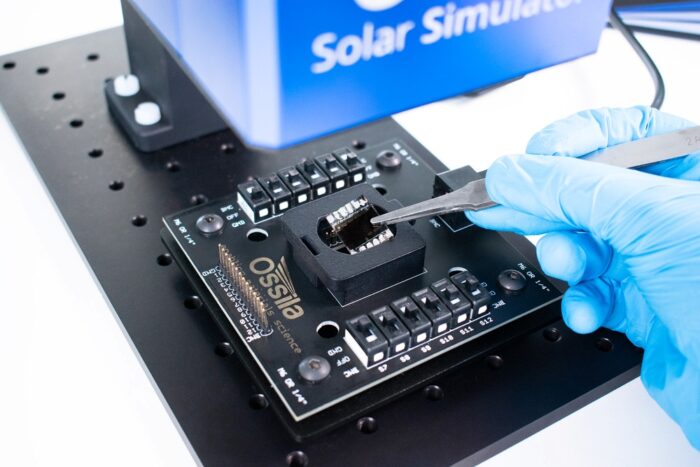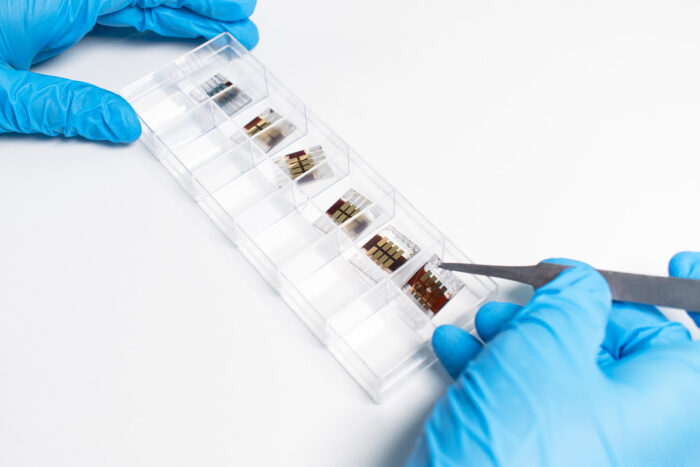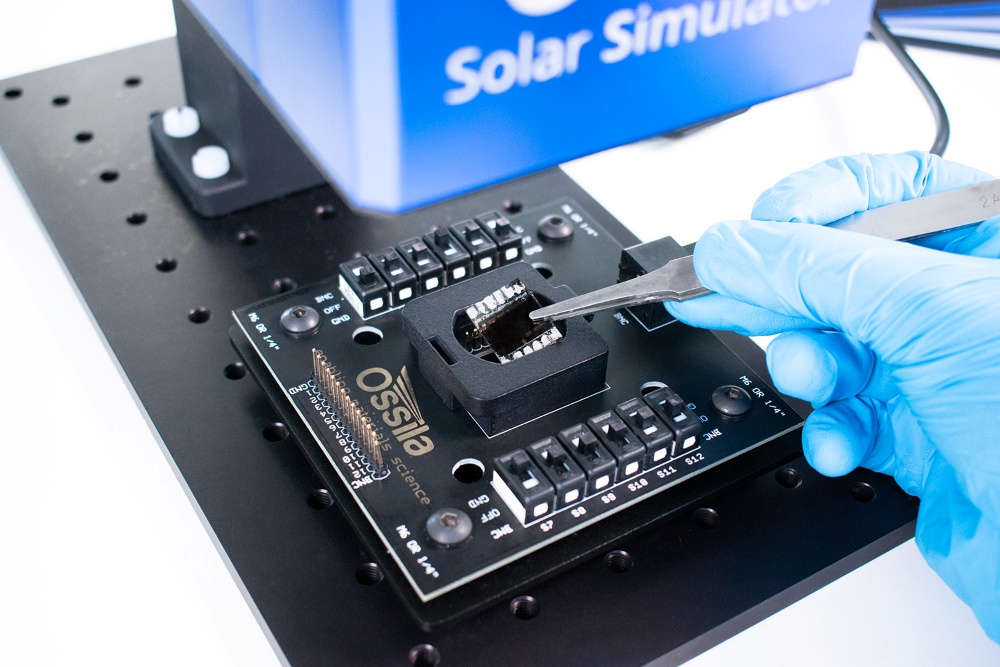April 7, 2025

By Mary O’Kane | Ossila Ltd.
According to the International Energy Agency (IEA), investments in solar energy now surpass all other power generators. Yet the solar energy industry is now confronted with an increasingly powerful opponent: extreme weather.
The intergovernmental panel for climate change (IPCC) has confirmed that people have already escalated the frequency and intensity of extreme weather conditions by people. Hurricanes, heavy snowfall, hail showers and heat waves stimulate innovation in technology for solar panels to build systems that are resilient enough to resist these circumstances while maintaining efficiency and lifetime.
Extreme weather impact
Solar panels are designed to withstand a series of environmental conditions, but the increasing severity and frequency of extreme weather conditions shift these limits. Although research by the National Renewable Energy Laboratory (NREL) has established many cases of extreme weather that only 1% loss of energy per year led, it also showed that in some cases of floods and strong wind a loss of 60% in annual energy production was experienced by individual systems.
The research also emphasizes that photovoltaic systems experience long -term degradation when exposing to heavy weather, such as large hail showers and strong winds. Hagel showers pose a direct threat to the glass that protects solar cells that can cause cracks that can endanger the performance. In addition, intense heat and UV radiation relegates the materials of the solar panel over time, while heavy snow and ice add excessive weight and impedes energy production. These effects not only reduce the energy output, but also result in expensive repairs or replacements, so that financial voltage is added to solar projects.
As new solar technologies enter the commercial market, understanding and reducing the effects of extremely weather is essential to guarantee their resilience and efficiency.
Test standards and certifications
The increasing frequency and intensity of extreme weather conditions have expressed their concern about whether the current test standards and certifications for solar panels are sufficient. Studies suggest that existing protocols often do not fully take into account the effects of such circumstances, which emphasizes the urgent need for stricter test measures. In June 2024 KWH Analytics reported that weather-related damage to solar assets exceeded the modeled expectations by 300%.
For example, the IEC 61215 standards for solar panel status solar panels must tolerate 11 effects of 25 millimeters (1-inch) hail. Nevertheless, the Institute for Energy Research reported paralyzing damage to solar farms in hail-sensitive regions of the US in both March 2024 and June 2023. Since the installations would have passed the IEC 61215 tests, the Renewable Energy Test Center (RETC) advises that manufacturers adopt an raised test protocols.
In order to improve the resilience of solar systems against extreme weather, manufacturers and test organizations must first identify the damage thresholds for different components. The development of suitable standards and subsequent test scenarios would ensure that extreme weather resistance is built into the design of the solar panel.
In the meantime, emerging technology, such as larger modules and thinner cells (with thinner for glass), can further increase the vulnerabilities of the system, unless it is designed correctly and tested rigorously.
Innovations in the design of the solar panel
New and emerging solar panel technologies are making more effort to take on the challenges of extreme weather conditions. These claims include three important areas, which ensure that solar systems remain reliable and cost-effective, even in the light of unpredictable environmental challenges.
Improved materials
Modern solar panels are manufactured with advanced materials that are designed to withstand the more heavy weather conditions:
- Progress in Incaping materialsSuch as multi -layered polymers to protect sensitive components against moisture and UV breakdown.
- Solar cells are now formulated with high-temperature-resistant materials Maintaining efficiency even during prolonged exposure to extreme heat.
- Tempered glass with anti-hailcoating Offers robust protection against hailstones, preventing cracks and other damage.
- For areas that are susceptible to environmental debris, Self-cleaning and anti-sleeping coating Can reduce the accumulation of dirt, ash and snow. These coatings also lower the maintenance costs by keeping the panel surface clear.
Advanced structural designs
Structural innovations are tackling vulnerabilities for wind and snow, making installations more resilient. Stronger mounting systems with reinforced frames and aerodynamic profiles reduce the risk of detachment during hurricanes or strong winds. In snow-sensitive areas, adjustable tilting mechanisms ensure that panels change their angle to effectively throw up built-up snow, thereby preventing excess weight and the energy output is maintained during the winter months.
Emerging flexible and flexible panels are a solution for areas that are exposed to strong wind. These designs, which often use thin film technology, can reduce the chance of damage by absorbing stress and bending instead of breaking.


Smarter Technology Integration
Artificial intelligence and big data transform the design and maintenance of solar panel systems, which stimulates significant progress in sustainability, adaptability and efficiency. By using predictive modeling and climate data, manufacturers can anticipate regional environmental challenges and engineering systems that are tailored to specific circumstances. These technologies also optimize maintenance by monitoring wear, predicting potential problems and making proactive solutions possible, so that the long -term reliability of solar panels is even guaranteed in the heaviest environments.
Within installations contain modern tracking systems, traditionally used to adjust panel corners for optimum sun exposure, now intelligent algorithms that are able to detect heavy weather. These systems can reposition panels, such as tilting flat during strong wind or more vertically in hail showers to prevent damage and to guarantee operational continuity.
Stand the next generation of solar materials?
The resilience of the next generation of solar materials for extreme weather is a crucial factor in their adoption and long -term success. Materials such as perovskites, quantum spots and organic polymers are at the forefront of solar innovation, but can they resist extreme conditions?
Perovskites
Perovskiet solar cells represent a breakthrough in solar technology, with a unique crystal structure that provides high efficiency and cheap production. Lightweight, flexible and equipped with an adjustable band gap, they are particularly suitable for tandem cells in combination with silicon or other materials. However, perovskites are much less durable than silicon, with vulnerabilities for moisture, oxygen and UV light – limitations that they currently do not place as a favorite for extreme environmental conditions. At present, their high efficiency is achieved using inert environments such as a glove box.
Recent progress in encapsulation techniques, hybrid organic inorganic structures and material formulations have improved their stability, improving the resistance to heat and UV-exposure. Although they are still confronted with challenges with humidity and temperature fluctuations, perovskites are increasingly being weather -resistant, so that the road is released for wider acceptance in the future in various environments.
Quantum spots
Quantum DOT solar cells are half -guided semiconductors on nano scale to absorb specific light wave lengths and convert them efficiently into electricity. They make their lightweight, flexible design and the ability to catch light over a wide spectrum very versatile.
Although quantum spots perform well in controlled environments, they are susceptible to breakdown when they are exposed to oxygen or moisture over time. To prevent this, the progress in surface passengering and encapsulation have considerably improved their resistance to environmental stressors. Although it is still sensitive to oxidation, protective layers have improved their sustainability, making quantum dot sun cells constantly viable in demanding circumstances and promising for applications that require a high efficiency and adaptability.
Organic
Organic photovoltaisies (OPDs) offer a lightweight, flexible and environmentally friendly alternative to traditional solar technologies, produced at low costs with considerable adaptability. These carbon-based materials are ideal for portable devices and niche installations where flexibility and lightweight properties are prioritated.
OPs, however, are generally less durable than inorganic materials, with performancegradation as a result of UV exposure, oxygen and moisture. Progress in synthesis and encapsulation techniques have extended their operational life, improved stability and made a feasible choice for applications where extreme sustainability is not a primary requirement, such as photovoltaic covered.
Lifelong Zonne
As extreme weather conditions occur more often, the durability of solar panels becomes a cornerstone of the global energy transition. The promise of solar energy is not only in its ability to provide the world with power, but also in its ability to do this resilient, regardless of the unpredictability of nature. Panels that are designed to withstand heavy conditions-such as hail, strong wind and heavy snow games a crucial role by reducing maintenance costs, improving operational efficiency and guaranteeing long-term reliability.
Every development of new solar technologies must therefore appreciate stability and sustainability as much as efficiency to be viable. For technologies of the next generation, while the efficiency of perovskiet and organic solar cells is rapidly increasing, this means nothing if they cannot be implemented in the real world. It is therefore necessary that test standards and academic results recognize and test for extreme circumstances and ideal circumstances.
Dr. Mary O’Kane is an application scientist at Ossila Ltd. She completed a Ph.D. Specialized in the scalability of perovskiet solar cells. During this time she was a co-author of various research documents and conference presentations on perovskiet and organic photovoltaic research, as the main researcher in various important projects.
Tags: Montage, PV design

